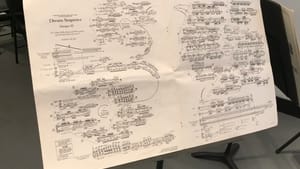Stay in the Loop
BSR publishes on a weekly schedule, with an email newsletter every Wednesday and Thursday morning. There’s no paywall, and subscribing is always free.
Beautiful music—for the ear and the eye
Orchestra 2001 presents George Crumb: Scores at an Exhibition

Remarkable concerts abounded this spring. Add George Crumb: Scores at an Exhibition to that list when Orchestra 2001 presented three seminal works by lauded Philadelphia composer George Crumb (1929-2022). As well as a riveting concert, the event included an exhibition of Crumb’s imaginative hand-notated scores.
The concert was gorgeous, but so are these written scores. Exquisitely made, they feature impeccable, almost unbelievable, excellence of notation, much admired by my composer companion. The scores were mounted in simple white frames hung at eye level, and a gallery setting (even one as modest and severe as West Philadelphia’s Slought Gallery) allowed a viewer to appreciate their remarkable, compelling visual architecture.
Especially arresting were scores for “Spiral Galaxy” from Makrokosmos Volume 1, and “Twin Suns (Doppelganger aus de Ewigheit), SYMBOL Gemini,” both in Crumb’s signature circular format. As works of art, these are the 20th-century equivalent to the Latin chant manuscripts so painstakingly created by medieval monks.
A thrilling chamber concert
Orchestra 2001’s excellent printed program noted that people are often surprised to find that many of the published scores from which musicians play are actually photo reproductions of Crumb’s hand-notated works, and this was readily visible in the intimate room where the evening’s thrilling chamber concert took place.
Presented without intermission, it opened with Dream Sequence (Images II), a 1976 work scored for violin (Molly Germer), cello (Ulrich Böckheler), percussion (Brenda Weckerly), and piano (Marcantonio Barone). Instrumentation also called for a seven-pitch “glass harmonica”—wine glasses filled with water—played offstage (four goblets) by Adam Lesnick and Mark Loria and onstage (three) by Barone.
This 15-minute work opens with a softly played gong and the resonant offstage glasses. The strings punctuate Crumb’s undulating sound clouds—sometimes soft, sometimes piercing—but the “melody makers” here are piano and percussion. Weckerly’s assortment included temple bells, crotales, suspended cymbals, sleighbells, and maraca, while Barone (in addition to the piano) had a Thai wooden buffalo bell and his three tuned glasses.
Barone’s brilliant piano
In addition to playing on the piano’s keys, Barone played inside the instrument, a Crumb signature; this “prepared piano” had pieces of paper across the strings. Fragments of melodic motif float throughout the rhapsodic Dream Sequence, beautifully played, creating the dreamlike quality mandated by the composer: “poised, timeless, breathing as an afternoon in late summer.”
Next, Barone, who worked extensively with Crumb, gave a 10-minute personal view of the composer’s life and compositions. A compelling and virtuosic pianist, Barone is a specialist in contemporary American music, especially Crumb’s works. He then launched into the first of two solo piano pieces, the brief “Agnus Dei” from Makrokosmos, Volume 2, #12. Makrokosmos (1972-79) is a massive four-part series of piano pieces, its title referencing Mikrokosmos, piano works by 20th-century composer Béla Bartók. Crumb’s work was partially composed during the Vietnam War, to which he was opposed, and he famously notated this Agnus Dei in the form of a peace symbol. The elegant, hushed work is played on both keyboard and strings, concluding with the pianist whispering “dona nobis pacem (grant us peace)” as the music drifts away.
Artistry to savor
The 90-minute concert concluded with the magnificent Metamorphoses, Book II; Ten Fantasy Pieces (after celebrated paintings) for Amplified Piano (2018-20). Modeled on Mussorgsky’s famous Pictures at an Exhibition, Crumb wrote 10 movements based on works of art that inspired and moved him. The printed program showed these 10 paintings, and it was illuminating to look at the images by Klee, Wyeth, Dinnerstein, Gaugin, Klimt, Picasso, O’Keefe, Chagall, and van Gogh as the brilliant music unfurled.
To fully interpret what he experienced visually, the composer used a “range of timbral techniques” including pizzicato, glissando, and harmonics (ways to bend pitches) and amplified the inside of the piano with objects like metal rulers, a muting stick, or a metallic jewelry chain. Much as string players retune, Barone “re-prepared” the instrument between sections. To allow him to easily reach inside the piano, its music rack was raised up on large volumes (The Symphonies of Joseph Haydn and the Oxford Companion to Music).
The 38-minute piece includes spoken sections and Barone also played an array of small instruments staged within his reach. It’s a monumental work, written in conventional (not architectural) notation, each section a miniature masterpiece remarkably attuned to its referenced painting. Especially notable were glittering musical ripples mirroring Klimt’s famous Portrait of Adele Bloch-Bauer (Lady in Gold) and violent, strident cadences illustrating Picasso’s Guernica. The program (and this work) closed magically with an ethereal interpretation of van Gogh’s Starry Night, unexpectedly gentle music evoking the myriad brushstrokes of that painter’s swirling stars.
Metamorphosis Book II was written for and first recorded by Barone, who also premiered this great work. His performance here was magnificent: nuanced, authoritative, and deeply explored. Crumb’s iconoclastic notation and instrumentation, including his “prepared piano,” might at first glance seem tricksy or peripheral. But they are not. They are the brilliant results of a lifetime exploring the essence of music and the piano’s relationship to it, something which Barone—a master of the keyboard—deeply understands, appreciates, and communicates to a grateful audience. It was a remarkable evening, to be savored and long remembered.
What, When, Where
George Crumb: Scores at an Exhibition. Marcantonio Barone, piano; Molly Germer, violin; Ulrich Böckheler, cello; Brenda Weckerly, percussion; and Adam Lesnick and Mark Loria, offstage glass harmonica. Orchestra 2001. May 24, 2023, at Slought Gallery, 4017 Walnut Street, Philadelphia. (267) 687-6243 or orchestra2001.org.
Accessibility
Slought Gallery is street-level and wheelchair accessible.
Masks were not required.
Sign up for our newsletter
All of the week's new articles, all in one place. Sign up for the free weekly BSR newsletters, and don't miss a conversation.

 Gail Obenreder
Gail Obenreder